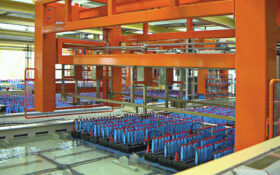Canadian energy storage firm EEStor Corporation has entered into a letter of intent (LoI) to merge with research firm FWG in a bid to commercialise an alternative to lead-acid batteries.
The LoI paves the way for the integration of EEStor’s composition modified barium titanate (CMBT) powder and the UK firm’s graphene and carbon-based materials.
FWG’s battery uses doped carbon structures in a bipolar arrangement in order to produce a compact device with energy density in the region of lead-acid, around 50-60Wh/kg depending on size and physical structure.
Robert Murray-Smith (pictured), co-founder and CEO of FWG, said: “The unique points of the battery are not so much the energy density, which is more than acceptable to compete head-to-head with lead-acid, but rather in the cost of production, which has been reduced significantly meaning the cost of producing our devices is well below all other currently manufactured energy storage technologies.
“This significant reduction in finished product costs has been achieved through the use of dry electrode manufacturing techniques, bipolar cell arrangement and the use of carbon, a readily available, inexpensive active material.
“It is envisioned that this generation of our battery can compete very effectively in the lead-acid battery space, which currently accounts for around 55% of the entire global battery market.”
Ian Clifford, founder and CEO of EEStor said: “The acquisition of FWG will allow for the targeted rollout of specific types of energy storage to address the most dynamic needs globally.
“Included in the initial targets is the replacement of the ubiquitous Group 27 lead-acid battery with a carbon-based battery that matches or surpasses the storage, operational and economic performance of lead acid without any of the catastrophic environmental implications.”
EEStor plans to buy all of the outstanding share capital of FWG following third-party certification by National Physics Laboratory of Great Britain and Intertek to ensure the performance characteristics of the technology are fully validated and disclosed.












